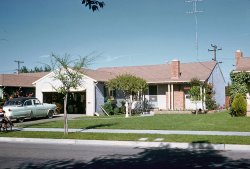
MAY CONTAIN NUTS

Search Shorpy
SHORPY ART

Framed or unframed, desk size to sofa size, printed by us in Arizona and Alabama since 2007. Explore now.
Join and Share
Ad-Free Shorpy
Shorpy is funded by you. Patreon contributors get an ad-free experience.
Learn more.

Recent comments
- Side Winder
- Air Quality?
- Sojourner Truth riot
- None were so blind(ed)
- The less famous sister
- Good ol' days?
- Rise and Fall
- Goo Goo Ga Joob
- Ticket Retention
- Not the only one
- Vagaries of War
- Killed by Amtrak
- Back to the Future
- Wanted --
- If you can't stand the light
- Centralized Traffic Control, I believe
- What's really happening
- Heckuva remote control!
- Sometimes — Things Go Bump!
- I SEE THE LIGHT
- Union Switch and Signal Company
- Get That Light Out Of My Eyes
- Eggs. Eggs. Eggs. The Egg Man is Here!
- Foreboding caption
- Famous Hollywood faces
- Not just S&P
- re: Those things in the jar
- Up In Smoke
- Medical Smoking
- Quick fix
Member Photos
The Shorpy
Print Emporium
Print Emporium
Search Shorpy
Search results -- 30 results per page
- Pain's Spectacle: 1905
- ... Beach, N.Y." At left, a sign pointing the way to the bicycle track as well as "Pain's Spectacle in Fireworks." 8x10 inch glass ... Posted by Dave - 04/09/2016 - 5:55pm -
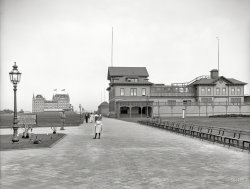
- Our Gang: 1935
- ... certain website name.
Ah.... The Good Old Days ! No bicycle helmets, no padded playground, no parents scurrying after the kids to ... Posted by Dave - 12/10/2014 - 2:27pm -
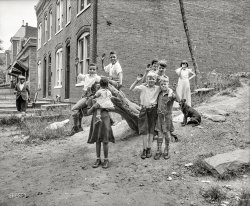
- Steel Wheels: 1942
- ... turned by their own wheels - sort of like a giant bicycle headlight. Each car would have its own generator, and batteries for ... Posted by Dave - 10/28/2013 - 11:31am -
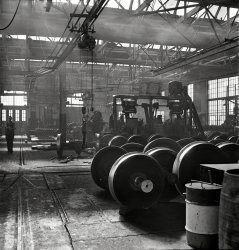
- The Seaside: 1905
- ... of Wheels 1. Motor vehicle
2. Horse drawn wagons
3. Bicycle
4. Entrepreneurial fellow with the wicker push chair
5. Mom with ... Posted by Dave - 08/13/2013 - 4:03pm -
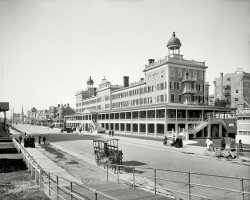
- Han Wah Laundry: 1901
- ... the woman hurrying away with a baby buggy; the abandoned bicycle; the shadow pattern on the pavement that calls to mind a devilish face. ... Posted by Dave - 10/08/2020 - 2:15pm -
![Han Wah Laundry: 1901 Washington, D.C., circa 1901. "View of Sixth Street N.W., west side, looking north from I Street." 5x7 inch glass negative, D.C. Street Survey Collection. View full size.
Tree wrapit looks like the trees are wrapped in chain link fencing.
Can anyone explain?
[Curbed horses tend to nibble. - Dave]
News ItemThe Washington Post -- Aug. 14, 1903
Han Wah Moy's Clothes Gone
Han Wah Moy, who conducts a laundry at 900 Sixth street northwest, failed to secure the door properly Wednesday night when he retired, and some one entered, carrying off the celestial's garments and a $5 bill which was in one of his pockets. Moy discovered the loss yesterday morning and, coming to police headquarters in borrowed clothes, reported the theft.
Still Going Strong!!This may be the first time that the D.C. Street Survey buildings shown are still here.
Re: News ItemFor a moment I thought stanton_square was back. (Note to new Shorpsters: this informative commenter, not seen for a few years now, provided relevant news items contemporaneous with the posted photo, in a distinctive format very similar to Dave’s comment.) I wonder where he / she got to.
Future shockThere are signs and portents here of the Han Wah Laundry's future: a disembodied foot and the faint ghostly images of passers-by; the blurred image of the woman hurrying away with a baby buggy; the abandoned bicycle; the shadow pattern on the pavement that calls to mind a devilish face. A century later the quieter pace of a quieter age is gone.
Bike & Camera CaseIs that our photographer's bike and camera case in the lower right corner of the image? I would suspect a tripod was also involved unless the camera was supported by some physical object like a wall etc.
[The case is for the photographer's glass negatives. - Dave]
(The Gallery, Bicycles, D.C., D.C. Street Survey, Stores & Markets)](https://www.shorpy.com/files/images/SHORPY-40305a.thumbnail.jpg)
- Happy Thought: 1940
- ... by. Same for tractor tires, truck tires, wagon tires, even bicycle tires! So many farm families lived miles and miles "from town" they had ... Posted by Dave - 12/19/2018 - 12:41pm -
![Happy Thought: 1940 September 1940. "Mrs. Garland and her little boy. Family lives in the submarginal farm area of Rumsey Hill, near Erin, New York." Medium format acetate negative by Jack Delano for the Farm Security Administration. View full size.
Lots of PotsThat stove looks huge and can accommodate so many pots but I guess once you made the fire, you had to cook everything at once instead of making things one after another. Perhaps she had a large family (or planned to) and this was a wise purchase.
Another thought -- during harvest season my grandparents would hire threshers to come in and harvest everything in a short period of time. The farm wife was responsible for feeding them. This probably came in handy if used for those times too.
Shoe problemMr. Delano must have shown up when no one was ready. Maybe scurrying around to get their shoes on. The little boy either didn’t get both shoe on on decided he didn’t want to wear two shoes. Mother simply didn’t have time to tie her shoes, I suppose. Anyway, that is quite a remarkable stove!
[That's a baby shoe. Our young lad has both shoes on. - Dave]
Threshing, heat, and canningThat big stove is probably for a bunch of reasons, starting with the fact it was probably a main source of heat for the home. It also would come in handy for not only threshing season, but also canning, preserving, boiling down maple syrup, baking bread & pies, and even heating water for doing laundry. It's impressive how much oven you can use when you're doing all that.
Close your mouth, you'll catch a fly.That's what my old dad would tell me when my mouth was hanging open like this young lad's.
Give me gas (stove that is)The stove was a critical appliance. My family were from the anthracite region in northeastern Pennsylvania. My aunt had a coal stove. It had to be kept burning all year round. It was a pain to re-light so extended trips from home were few. In addition to cooking, it was the primary source of heat and hot water. There were metal grates in the floors upstairs to let the heat rise up in the winter. For really cold days she had a second coal heater in the "parlor," as she called it. She had this setup until she had to move into a "home."
Maybe the result of living through the Depression, but my family never updated anything without good reason. Things were used until they broke and couldn't be repaired.
Shorpy StoveNice placement.
The Stove That Made Pittston FamousFounded in 1869, the Pittston Stove Company's business took off after 1873, when Samuel Smythe, an engineering pioneer with 25 patents, designed a duplex grate, which became an industry standard.
The company shipped $175,000 worth of stoves in 1917, the equivalent of $3.2 million today. The one shown in this ad has much fancier ironwork but the components are similar the Garland family's version.
Re: Give me gas (stove that is) I have had many conversations as a curious teen, and even more curious adult with my grandparents, as well as my husband's Indiana farmer grandparents of German farm family roots over the last 40 years. In those conversations, I discovered that due to not only the Great Depression, but general farm family economics, combining a lifetime of thrifty farming ways, plus the aforementioned Depression, AND WWII, they just lived that way, because that's the way things were. While "the men" - meaning the grandfather and any uncles that remained to follow in their father's footsteps - ruled the roost regarding not only farm operations, but economic ones as well. Grandmothers - mothers at that time, of course - ruled the home, and all operations taking place inside it, but only to the point where the economy would allow. The furnishing of the kitchen, the sewing room, the canning storage, water supply, and other utilities were ruled by the amount of money available coming from the economies of the farm operations, which always came first. If electricity were to be furnished to the property, it came to benefit the running of the farm first, and then the house IF there was enough left over to do so. So, the harder the men worked, and the more money that came from those efforts, the more everyone would benefit. Updating the features of the farm home was practically impossible not only during depression times, as there was no money to do so, until the Federal government and the FSA began getting involved in helping farm families pull themselves out of the Great mire they found themselves buried in during the very late thirties.
But, it all came to a halt during the War years, because even though there was more money in the bank finally, there was little to nothing to buy! Restrictions, rationing and priorities on metals reduced new farm equipment to absolute minimums, if not down to nothing to be had at all. Even repair parts were almost impossible to come by. Same for tractor tires, truck tires, wagon tires, even bicycle tires! So many farm families lived miles and miles "from town" they had difficulty getting there to buy anything, if there was anything to buy. Going to the local co-op for seed, feed, and fertilizers - also difficult to get in needed quantities - was about as close to shopping as many farmers or their wives would get for years.
My husband's grandmother never learned to drive, and she was relegated to sending a list with grandpa to get the things she needed, so she had to depend on him entirely for several years to get her shopping done. The only time she left the house for years was to go to church down the road about two miles on Sunday mornings. Sometimes she would be able to send mail orders in from her Sears catalogs, if they had what she wanted for the money she had to spend. She had three sons and one daughter, born in a period of 36 months from the birth of the first to the last, all by C-sections, in the mid-30's, so those trips to the hospital were also rare outings! And extended rests, with other local church acquaintance farm wives coming to help her out for the first few weeks after each one came. Cloth diapers were washed daily in a bucket, rinsed twice in the wash tub, run through the wringer, and hung on the line in the sun to dry. Laundry wasn't just a Monday only job, with farmer's overalls getting filthy on a daily basis. Nobody had a week's worth of clothing to get from Monday to Sunday.
Gasoline restrictions and rationing certainly didn't help that, as you didn't get far on three gallons per week. Gasoline meant for farm equipment only had been colored with a red dye, and if you were found to be running farm gas in your automobile, there was severe fines that could be levied. So, keeping things running, and fixing instead of replacing were the rules of the day all during the War years as well. Once all those restrictions, rationing, priorities, etc., were over with, it wasn't so easy to just start throwing things out and buying new. Not when you had been doing things that way practically all your life.
Mrs. Helen Struble Garland, age 31This is most likely Helen Garland and her 3-year old son Chauncey. Per the 1940 census, Helen lived with her husband Clarence and five young sons in Van Etten, NY, where her husband worked as a woodcutter. Helen and Clarence both lived into their eighties.
(The Gallery, Jack Delano, Kids, Kitchens etc., Rural America)](https://www.shorpy.com/files/images/SHORPY-8c03149a.thumbnail.jpg)
- Grease: 1925
- ... by a former self-titled world champion high-wheel bicycle racer, Englishman Jack Prince. Playa Del Ray was the first built, in ... Posted by Dave - 10/22/2012 - 10:54am -
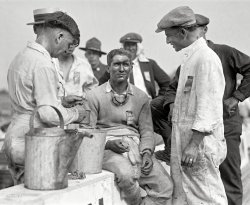
- Curb Work: 1920
- ... Luchs Real Estate, the business located behind the parked bicycle around the center of the photo, was around until 1993, when it was ... Posted by Dave - 08/09/2013 - 6:51pm -
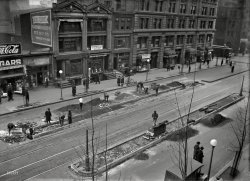
- The Cordova: 1891
- ... I would have guessed a little later then 1891. The safety bicycle and the men's boaters look more like 1901 to me.
[That 44-star ... Posted by Dave - 08/13/2013 - 4:04pm -
![The Cordova: 1891 Florida circa 1891. "Cordova Hotel, St. Augustine." 8x10 dry-plate glass negative by William Henry Jackson. Detroit Publishing Company. View full size.
America with a few states lessBeautiful hotel complete with fountains, gardens and a 44 star American flag.
Casa MonicaNow the Casa Monica Hotel. Whose website has a nice history page.
View Larger Map
1891I've been in the coffee shop at the base of that tower many times. One of my favorite people watching places.
I would have guessed a little later then 1891. The safety bicycle and the men's boaters look more like 1901 to me.
[That 44-star flag would have been a tad out of date by then. - Dave]
Great placeI got engaged at the Casa Monica in 2000. It's hard to imagine living in Florida before AC.
(The Gallery, Bicycles, DPC, Florida, W.H. Jackson)](https://www.shorpy.com/files/images/4a03477a.thumbnail.jpg)
- Louisville Wharfboat: 1905
- ... years the bridge has been restored to allow pedestrian and bicycle traffic to cross the river.
(The Gallery, Boats & Bridges, DPC, ... Posted by Dave - 07/07/2014 - 12:47pm -
![Louisville Wharfboat: 1905 Circa 1905. "Ohio River levee at Louisville, Kentucky." Note the "U.S. Life Saving Station." 8x10 inch glass negative, Detroit Publishing Company. View full size.
Connected finallyThe Big 4 bridge in the background is now a pedestrian bridge connecting the 2 sides (finally). It's a great addition to downtown.
Busy!There sure is a lot going on in this photo!
Still afloat!The Life Saving Station(#10) is still there and is now used as the wharfboat for the historic sternwheeler Belle of Louisville.
[The present Life Saving Station #10 dates from 1929. -tterrace]
Ol' Reliable That Old Reliable Laundry cart in the middle looked pretty new - so I looked and found a Google Book's result that said it was Organized Aug, 4, 1904, for $3,000 and paid $3 in tax. So, the cart (or the paint job on the cart) was probably a year old or so old when the picture was taken.
Railroad BridgeThe bridge in the background appears to be the "Big Four" bridge which was built to carry the Cleveland, Cincinnati, Chicago and St. Louis railroad (Big Four) across the Ohio River. If it is the Big Four bridge it is the first one; the bridge became inadequate for the traffic and was replaced in the late twenties. The Big Four eventually was merged into the New York Central and railroad traffic on the bridge was ceased. In recent years the bridge has been restored to allow pedestrian and bicycle traffic to cross the river.
(The Gallery, Boats & Bridges, DPC, Louisville)](https://www.shorpy.com/files/images/SHORPY-4a22248a.thumbnail.jpg)
- Lake Front Depot: 1899
- ... in.
Her main lines have since surrendered to becoming bicycle and hiking trails. If I believed in ghosts I would spend endless hours ... Posted by Dave - 03/15/2018 - 6:59pm -
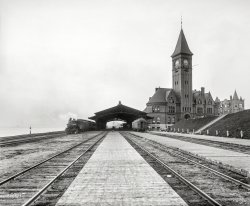
- Old-School: 1953
- ... rain, snow, or shine on a 1950 English 3-speed Rudge bicycle to school every day. I rode that Rudge through 1970 in college. The ... Posted by Dave - 07/20/2015 - 10:17pm -
![Old-School: 1953 Jan. 29, 1953. "Greenville School, town of Greenburgh, New York. Foyer." At right, "Third Grade Paintings." 5x7 negative by Gottscho-Schleisner. View full size.
FamiliarI'm sure this looks familiar to Shorpyites of a certain age - it looks just like my elementary school in Michigan. Most of the 50's and 60's schools seemed to share the same DNA. Many of those windows were blocked off and insulated in the panic of the oil crisis in the '70s.
Natural Light EverywhereThe complete LOC set is fascinating. Love these midcentury school designs, with abundant natural light in classrooms--and windows that open!--very unlike classrooms in the school where I teach (built in the 1990's). For the nerdiest among us, here is an interesting history of school design 1900-present.
Academic AromasAhhh, the scent of a mid-century American elementary school. Our sense of smell and the way our brains organize memory (the olfactory bulb is part of the brain's limbic system) are very closely related; aromas can call up memories and powerful responses almost instantaneously. I guess it works in reverse, too, because seeing this school scene caused ghost scents to appear in my office this morning as I indulged my coffee and breakfast taco and Shorpy habits. The phantom aromas have to be strong to overpower a taco and cup of Ruta Maya…but here’s what I detected:
*The indigo dye in brand new blue jeans
*A whiff of Cavendish pipe smoke coming from the principal’s office
*Sweaty kids – not the sourly rank teen kind, but the innocent 4th grade kind
*Mimeograph ink
*Fish sticks and sheet cake from the cafeteria
*Wood shavings from the pencil sharpeners
*Bic pen ink
*Cardboard Duo-Tang folders
*Cut grass from the playground
*Crayola crayons and construction paper
*An olfactory stew of gum eraser, chalk dust, and Elmer’s glue
*Ms. Borcherding’s rose petal perfume and Aqua-Net hairpspray
And perhaps my most vivid olfactory memory: the faintest hint of “Charlie” perfume, booze and cigarette smoke wafting around the hot-before-I-knew-what-hot-was library assistant Ms. Sherri D’Amato (Cherry Tomato).
Goober Pea
Re: Academic AromasOne more: that green stuff the janitor threw on the floor before he swept.
ackModernist architecture and, yes, I went to schools very similar to this. They were, like most modernist designs, stiff, cold, and boring.
In this picture, gaze with head shaking at the Danish modern furniture, which I think was designed to be as uncomfortable and unattractive as possible.
Thank you. It's good to get that off my chest!
More than familiarThis doesn't look like my elementary school, this WAS my elementary school. I went to kindergarten here in 1955. I was put into shock this morning when I woke up to this photo. Funny, the only thing I remember were the naps. My brother went there too.
Hey, that's my schoolWhat a surprise today at my daily glimpse of Shorpy as I saw "my" Greenville School where I attended second through fourth grades from 1950-54. That Shorpy would single out such a relatively insignificant school in of all in the country seemed a bit strange so I did a double take to see that it was actually "my" Greenville School. Although I walked past the furniture in the foyer every day, my memory does not recall it after 62 years, yet that memory clearly remembers riding rain, snow, or shine on a 1950 English 3-speed Rudge bicycle to school every day. I rode that Rudge through 1970 in college. The Greenburg area of Scarsdale was a wonderful place to grow up.
Strangely, it was a 1958 photo of my new Redwood High School in Larkspur, CA that was posted on Shorpy some years back that got me to looking at Shorpy every day. Great site and many memories.
[You're in my 1961 Redwood Log yearbook, your senior year, my freshman. I posted that 1958 Redwood photo my brother took. -tterrace]
My Thoughts Exactly, Gooberpea!Upon seeing this photo of what could've been my elementary school at Kincheloe AFB, Michigan I too was overwhelmed with "aromatic" memories. I giggled to myself while thinking, "I wonder if anyone else associates memories with smells", and all at once I read your post, Goober Pea. Apart from Ms. Cherry Tomato, you got it, exactly!
Academic Aromas IIMy elementary school had similar smells as Gooberpea mentioned except for Ms. Borcherding’s rose petal perfume and Aqua-Net hairpspray since mine was the Shrine of the Little Flower.
No parochial student of my era '46-'52 could ever forget the smell of a rainy Friday. There was the aroma of wet boys' cudoroy school pants mingled with the aromas of the brown bag Catholic lunches of that era. Hardboiled eggs, fried eggs, salmon croquettes, fried fish and for a lucky few crab cakes created a meatless miasma of unforgettable smells.
(The Gallery, Education, Schools, Gottscho-Schleisner)](https://www.shorpy.com/files/images/SHORPY-5a17424u.thumbnail.jpg)
- Totally Tubular: 1960
- ... take them home, blow them up, and fix all the holes with bicycle patches or duct tape if none were handy. Then we'd head off to the ... Posted by tterrace - 11/27/2017 - 1:29pm -
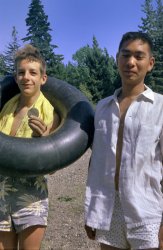
- Angel of the Waters: 1901
- ... a beauty This is a place I used to ride past on my bicycle every day, and still go to as often as possible. The trees and the ... Posted by Dave - 06/15/2019 - 1:57pm -
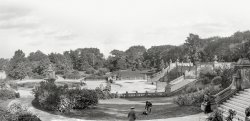
- The Commercial Vampire: 1898
- ... (same as the milliners)
Druggist: Peoples Drug
Bicycle dealer: Wheaton Cycles
Shoes: Hahn Shoes
Grocer: We still have ... Posted by Dave - 11/01/2013 - 9:33am -
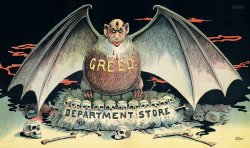
- Little Dipper: 1915
- ... (where the mules walked to tow the boats) converted to a bicycle/hiking trail. It runs from Cumberland, Md. to Georgetown (DC) along the ... Posted by Dave - 07/12/2018 - 3:53pm -
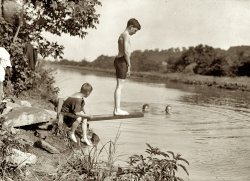
- Fast Living: 1925
- ... "Race car driver Peter De Paolo and Chas. Allen, Laurel bicycle races." National Photo Company glass negative. View full size.
... Posted by Dave - 08/07/2012 - 12:13pm -
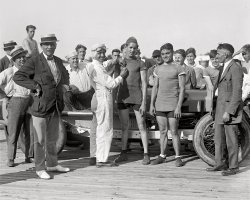
- Spook Hill: 1940
- ... looking a bit better, though I suspect the Basketball Hoop/Bicycle Rim is gone.
https://noehill.com/nv_storey/nev0087.asp
... Posted by Dave - 01/28/2018 - 6:35pm -
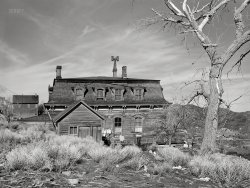
- Growing Boys: 1917
- ... before 10:30. Escorted by mounted police and headed by bicycle troop, with a Boys Scout band, the boys marched to New York avenue, ... Posted by Dave - 01/17/2009 - 12:07pm -
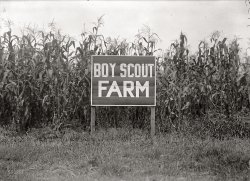
- Sailing on the Sand: 1903
- ... day's hang gliders. In the background we see a couple of bicycle people movers.
Appropriate Photo I just returned from my 50th ... Posted by Dave - 10/15/2012 - 9:26am -
![Sailing on the Sand: 1903 Circa 1903. "Sailing on the beach at Ormond, Florida." An interesting looking character at the controls. 8x10 glass negative, Detroit Publishing. View full size.
Major Hoople Au Bord de la MerA fez and a wool suit, Florida weather -- and Arrid won't be invented for a few years yet. The pilot looks as if he's calculating whether he can run over the photographer before the latter can gather up his tripod-mounted view camera and skedaddle (they still did that back then).
[Our captain would be bundled up against the chill -- Florida was a winter resort. -Dave]
In the Midwestthet thar is known as a "prairie schooner."
Boat For HireIt appears that one could buy rides on that contraption. Similar to the present day's hang gliders. In the background we see a couple of bicycle people movers.
Appropriate PhotoI just returned from my 50th High School Reunion in Daytona Beach (on the south edge of Ormond Beach for those that don't know). Everything is a lot different now than it was back then although I think it was better 100 years ago than now. We walked on the beach and in the ocean while there. The beach is much narrower now, even at low tide and they now charge a fee to drive on the sand. Great photo and I have enjoyed this one and the other photos of Daytona Beach shown on this site. They bring back memories of a time that will never come again. Thanks a lot.
(The Gallery, Boats & Bridges, DPC, Florida)](https://www.shorpy.com/files/images/SHORPY_4a10867a.thumbnail.jpg)
- For Love of the Game: 1912
- ... out of metal?
Who Knew? They used to do overhead bicycle kicks in American Football?
Final Score I looked up this game ... Posted by Dave - 08/04/2012 - 4:32am -
![For Love of the Game: 1912 1912. "Football, Costello; Georgetown-Virginia game." Costello seems to be having a pretty good time. Harris & Ewing Collection glass negative. View full size.
Technical AchievementThis is a wonderful example of a stop-action photograph, made in an era when such things were generally thought impossible to do. Before the 1930s, photo emulsions -- the light sensitive chemistry applied to glass plates or film -- were 'slow', meaning that you either had to have enormously high light levels or your subject had to remain relatively still. Compounding the problem were lens optics that were not terribly efficient at gathering up what light was available. Yet, here we have a photo that shows very little blurring and is on a par with that seen in Sports Illustrated. Kudos!
[That's a perception maybe encouraged by historical accounts of daguerreotype studios using neck braces on portrait-sitters to allow for two-minute exposures. But 60 years later in 1912, improved emulsions allowed for shutter speeds of hundredths of a second even on inexpensive cameras. There are hundreds of stop-action sports photos from the 1910s and 20s in the LOC archive, mainly the National Photo and Bain collections. Below, another photo from the Georgetown game. These were made using 5x7 plates. I think probably the most challenging part of photography like this would have been bulk -- the heavy camera, and glass-plate boxes that weighed 5 or 10 pounds -- and what must have been the cumbersome process of changing the plates for each exposure. It would be interesting to see an account of what that was like. - Dave]
ComicalThat's a good shot of Charlie Brown — where's Lucy?
Rubber or Metal?Please tell me that those cleats are made out of rubber?! Can you imagine being run over by those cleats if they were made out of metal?
Who Knew?They used to do overhead bicycle kicks in American Football?
Final ScoreI looked up this game in the Virginia football media guide. Georgetown won the 1912 game at home by a score of 16-13.
Georgetown and Virginia played 16 times between 1889 and 1913. The final record was 7 wins, 7 losses and 2 ties.
(The Gallery, Harris + Ewing, Sports)](https://www.shorpy.com/files/images/01677a.thumbnail.jpg)
- Washday Alley: 1923
- ...
Neatness Counts There doesn't appear to be any bicycle parts, old washtubs , newspapers, used tires or other debris in this ... Posted by Dave - 01/17/2015 - 2:08pm -
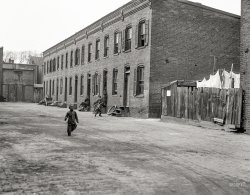
- Class Day: 1906
- ... this image. And imagine, a fellow could actually leave his bicycle unattended next to the curb and expect it to be there when he returns. ... Posted by Dave - 04/09/2015 - 10:17am -
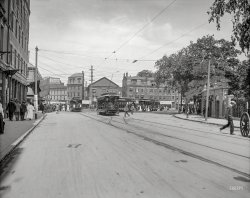
- Sk8r Dude: 1921
- ... of Herb and Joe and I'm more impressed every time. As a bicycle rider of more than fifty years, I can appreciate how difficult these ... Posted by Dave - 08/13/2013 - 4:10pm -
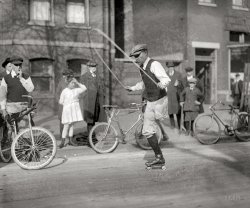
- Wood Jeweler: 1900
- ... the door, which was the term often used to refer to a bicycle in those years. In this case it is just a wheel, but assume it is ... Posted by Dave - 11/20/2014 - 5:09pm -
![Wood Jeweler: 1900 From circa 1900 in Parts Unknown comes this 4x5 glass negative of G.H. Wood Jeweler, the business, and possibly a Wood or two. View full size.
How about it Shorpy?How about awarding some of those much coveted 'bonus points' to any commenter who can name the man seen in the barbershop window reading a newspaper?
George and his brother?From the "Jeweler's Circular", March 10, 1920. I poked around on Central St. in Lowell, MA, hoping I might get lucky and spot the location, but didn't see it. There are an awful lot of old brick buildings on that street, though.
Edit: Given 20002ist's newspaper ad, and with my article giving about 40 years before 1920, and the sign that says, "Monday July 23rd", that would peg the year at 1883, 1888 or 1894. Though, it sounds like he might have a bigger store in that article than in this picture, so maybe it's 1883 or 1888?
[July 23, 1900, was also a Monday, and might be more in keeping with the light fixtures in the window display. - Dave]
Edit: True, I should have mentioned 1900 as a possibility. It seemed like 7 years after that ad, things would have been more upscale, but it is possible as you say.
Another thought I had is that if one of the gentleman is Millard, then 40 years a jeweler would have possibly made him 20 years old (give or take) in 1880. It's a bit hard to tell, but I would say the tall one is late 20s and the other early 30s. So that would argue for closer to 1890 than 1900. I wonder when electrification came to Lowell.
[Not to mention light bulbs. - Dave]
Edit: Poking through Wikipedia and other sources, Lowell is actually one of the pioneers of hydroelectric power, which fed their industrialization. They were producing power by early-to-mid 1870s. So it's likely they would have been one of the first to get electric lighting, since they already had abundant power generators.
[The answer here, as hinted in the title, is 1900. - Dave]
Edit: Well, the "circa 1900" led me to believe that you didn't actually know the exact date, but if it is labeled as definitively 1900, that makes it interesting that the shop is such a hovel when 7 years earlier they had "goods bought in such quantities, where so many clerks must be employed," etc.
Edit: Just in case anyone else was wondering, electric lights were well established by 1893-1894, as seen in this Edison light bulb price list from 1893 or this 1894 office with electric lights.
No Cabots, but probably LowellG.H. Wood was a prominent jeweler in Lowell, Mass., as evidenced by the ad below from the Jan. 14, 1893 Lowell Daily Courier.
WheelLurking just inside the door, which was the term often used to refer to a bicycle in those years. In this case it is just a wheel, but assume it is attached to a cycle. We used to holler with laughter when our principal Miss Nina B. Glass (1881-1978) at Sanger Avenue Elementary would caution us about safety while riding our "wheels".
This is......a fascinating picture. Thanks for posting it!
Weird iron S on wallCan anyone explain what the use might have been of the 3 peices of S shaped metal? One above the door and two above the window. Did it hold something to the wall? I've seen these on other Shorpy buildings, so it just might be a stylized Shorpy S, similar to Nike checkmark.
[They are turnbuckle irons, manifested most frequently on these pages as the turnbuckle star. - Dave]
(The Gallery, Found Photos, Stores & Markets)](https://www.shorpy.com/files/images/SHORPY-133-02.thumbnail.jpg)
- Ectoplasmic Express: 1908
- ... and it would also appear from the streak of light that the bicycle that's parked by the curb on the left arrived while the lens was open. ... Posted by Dave - 01/20/2017 - 10:09am -
![Ectoplasmic Express: 1908 Niagara Falls, New York, circa 1908. "Falls Street at Night." A scene last glimpsed here. Note the ghost streetcar stopped mid-frame in this time exposure. 8x10 inch dry plate glass negative, Detroit Publishing Company. View full size.
Talking Pictures in 1908?Thomas Edison experimented with synchronizing a crank wound phonograph with his early moving picture film around the turn of the century...
[The poster to the right of the entrance announces the theater is using E.E. Norton's Cameraphone system. -tterrace]
This has me intriguedI've never heard of "Talking Pictures" this early. I wonder what they were.
[Explained in a comment to the earlier photo linked in the caption. -tterrace]
Ghost bicyclistWhat a great photo! I can spy a couple of ghosts on the sidewalk on the right, and it would also appear from the streak of light that the bicycle that's parked by the curb on the left arrived while the lens was open.
Barrel HoodA lovely "barrel hood" Franklin, parked at the curb
(The Gallery, DPC, Movies, Streetcars)](https://www.shorpy.com/files/images/SHORPY-4a23128a.thumbnail.jpg)
- Meats and Groceries: 1905
- ...
It was always a day of adventure from the rental bicycle Boardwalk ride to being allowed to eat salt water taffy just before ... Posted by Dave - 08/24/2011 - 1:24pm -
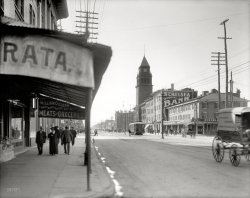
- Schwinn Sting Ray: May, 1965
- This isn't a picture of my Bicycle, my house or my cars, but it might just as well be. I remember my ... Posted by Vintagetvs - 09/18/2011 - 11:07pm -

- Dynasty: 1956
- ... One of the subjects of a photograph, a youngster with a bicycle in 1952, identified the photographer who lived from 1902-1999 as his ... Posted by Dave - 06/19/2012 - 2:05am -
![Dynasty: 1956 Southern California circa 1956. Some of our picnickers are back for a multi-generational, ensemble-coordinated portrait on the couch. View full size.
Hoping descendants look at Shorpy!I'm enjoying getting to know this family, as well as the time when I was a baby (I was born Sept. 1954), through these amazing photos! I sure hope someone will notice them and think, "Gee, that looks like Aunt Sally", or "They look like some neighbors we had growing up", etc.. Similar things have happened!
That family sure had a lot of pretty girls!
Image qualityHey Dave, how much clean up and adjustment was required on this image? Most of the slides in this series seem to be nicely color saturated, with good lighting, and devoid of the extraneous "junk" usually found on old slides. Nice job! (Is that our "loves olives" girl in the back?)
[The film scanner and software do all of the cleaning up. - Dave]
Bring back those styles!!Seeing photos like this from the 50's makes me long for the clothing styles of the times. You don't see any of these pretty ladies wearing t-shirts with logos on them or tank tops. They look beautiful and a good part of that is what they're wearing, and you can tell they know it.
SMILESWith all the headlines about damaged children screaming at us every day, it is a delight to see the beautiful smiling babe in your photo. Thank You!
Twins?What a beautiful & healthy family.
The two girls on either side of the Mom look like they could be twins. They're both wearing the same blouse as well.
A similar collection of photographsfrom the same time period, mid-50's, of African-Americans in Waco, Texas was found several years ago by historian Mike Cochran. There were 414 in all, black and white, in a bag in an antique shop. They needed lots of attention and he was able to get a grant to assist him in making them presentable and they are now available online at the link below. One of the subjects of a photograph, a youngster with a bicycle in 1952, identified the photographer who lived from 1902-1999 as his neighbor. There was a story about him recently in our local newspaper.
http://texashistory.unt.edu/explore/partners/PCMC/
(ShorpyBlog, SoCal 1956 Kodachromes)](https://www.shorpy.com/files/images/SHORPY_SoCal_women.thumbnail.jpg)
- Nuclear Family: 1958
- ... is a perfect Shorpy composition.
Old car, antenna, bicycle and kid. Even better if he was a paperboy (newsie). With a nice ... Posted by Truck5man - 01/22/2012 - 11:32am -
